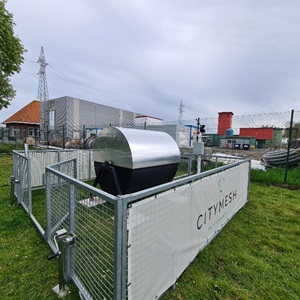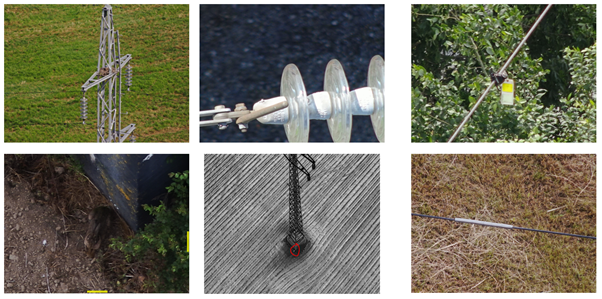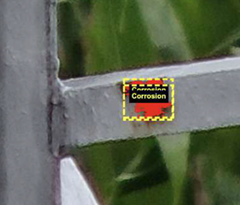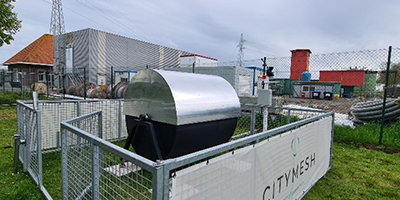12 October 2023
Revolutionizing Overhead Line Incident Response: Introducing Drone-in-a-Box (DiaB)
Drone-in-a-Box (DiaB) is a new emerging technology: a drone, housed and charged in a remote docking station, ready to take off on a request and operate Beyond-Visual-Line-Of-Sight (BVLOS).
Context
As a leader in the energy landscape, Elia is always on the lookout for ways to tackle incidents swiftly and efficiently on overhead lines. Incidents are any type of event where circuit breakers are forced to open. They can be caused by failing assets but also have numerous external causes such as lightning strikes, third party interference with lines, trees falling or crossing the lines. The goal of the Moonshot Asset Management is to find the cause behind incidents in real time. Remote technologies can assist in resolving the incidents by providing valuable information from the field as quickly as feasible to either capture the incident occurrence or offer an insight about what exactly has happened. For this, multiple technologies were considered including Drone-in-a-Box (DiaB).
Why this project
Drone-in-a-Box (DiaB) is a new upcoming technology. Imagine a drone, housed and charged in a remote docking station, ready to take off on command and operate Beyond-Visual-Line-Of-Sight (BVLOS). To test the viability and maturity of the technology we performed a proof of concept (POC). The hypothesis of the POC was that DiaB can provide relevant information on the cause behind overhead line incidents in real time.
Approach
 In cooperation with Citymesh, we set up a 5G antenna and docking station close to one of our substations. The drone was piloted over the local 5G network connected with the docking station. The captured images were live streamed over 4G internet connection to Citymesh's Remote Operating Center 40 kilometers away, and uploaded to a cloud platform.
In cooperation with Citymesh, we set up a 5G antenna and docking station close to one of our substations. The drone was piloted over the local 5G network connected with the docking station. The captured images were live streamed over 4G internet connection to Citymesh's Remote Operating Center 40 kilometers away, and uploaded to a cloud platform.
The drone had three cameras on board: a wide camera, a 20MP zoom camera and a thermal camera. Live video streaming and image recording of these three cameras was provided through the Citymesh platform. Elia personnel could log-in and view the inspection in real-time from their premises.
Video of the Drone in the box
Recording footage was automatically uploaded to the cloud platform to test an image recognition algorithm which Citymesh developed earlier to detect corrosion. The automatic detection of rust would proof the end-to-end technology feasibility: from operating a drone remotely and taking pictures, to having those pictures automatically analyzed to detect damage inflicted by incidents.
The goal was to find the perfect way to perform DiaB patrols on overhead lines. After a couple of days it was clear that flying above and next to the line while looking at a 45°angle down is the best option - zooming in for a closer look at the equipment then out for a wider perspective. Additionally that, 10 specific assignments were formulated to determine types of incident causes that DiaB could assist with.
ResultsIn two months, we performed 45 flights. Seven of the ten assignments satisfied the requirements, while three did not. Objects underneath the line down to 0,25m2 could be easily found, as well as big branches and such objects as agricultural vehicles. Equipment on the pylons is easy to get a good detail on when hovering close to the pylon. Example pictures are shown below.

The DiaB images come near to the VLOS images but do not match them exactly. Because of the safety reasons the BVLOS pilot couldn’t fly as low and as close to the pylon as a VLOS pilot would. The pictures were taken at different angles and distances than VLOS pictures would be taken. However, the image recognition algorithm was still able to detect corrosion developments proving the end-to-end feasibility of using DiaB for automatic damage detection inflicted by incidents. In the same was ay the algorithm on corrosion is trained, an algorithm on damages can be trained. In the image below you can see an example of automated corrosion detection.

The communication through 5G to the cloud platforms went well. The connection was always present 3,5km away from the tower and the livestream was followed by multiple stakeholders in different countries.
Tests confirmed that the drone can operate within a 5-kilometer radius under 10 minutes. The 5-kilometer radius is set due to battery life duration of 25-30 minutes. It only takes 10 seconds to get the docking station open. During that time, the remote pilot can set out a predefined path by setting out waypoints in the piloting software, so the drone automatically follows a predefined flight path during the patrol. It helps the pilot to focus on his mission and take the required pictures at the right spot.
Our conclusion: a patrol with a DiaB drone can well detect certain incident causes, such as incidents caused by third parties (cranes, trees, etc.) and material failure (isolator chains broken, isolator discs missing, conductors on the ground…). Incidents with less obvious causes are harder to be detected and situationally dependent. This should improve with more practice, more precise incident location pinpointing, and upcoming technical advancements.
Next steps
The following phase is to look for prospective DiaB locations, both alone and with the partners. It is not advised to run DiaB across the whole grid since not all event reasons can be precisely recognized by DiaB and due to the overall running expenses for the drone stations. It is advised to use DiaB to cover the places with the highest concentration of essential lines. To explore the possibility of sharing the DiaB infrastructure, we addressed a number of partners during the course of the project. Further discussions are now taking place in this regard.
Elia is also eagerly following the development of the EU legislation on BVLOS operations. DiaB operations are being rolled out at this moment in Belgium and Germany. These first operations are interpretations of the existing legislation. They pave the way towards a fully mature implementation and deployment of the BVLOS market.
Acknowledgment
For the project to be successful, our collaboration with Vinci Energies was crucial. It is a direct outcome of the launched by Elia Asset Management Ecosystem, where different utility companies across Europe have teamed together to exchange expertise and run cooperative initiatives like this one to discover and push the upcoming advancements in asset management.
Partners
 |
 |



